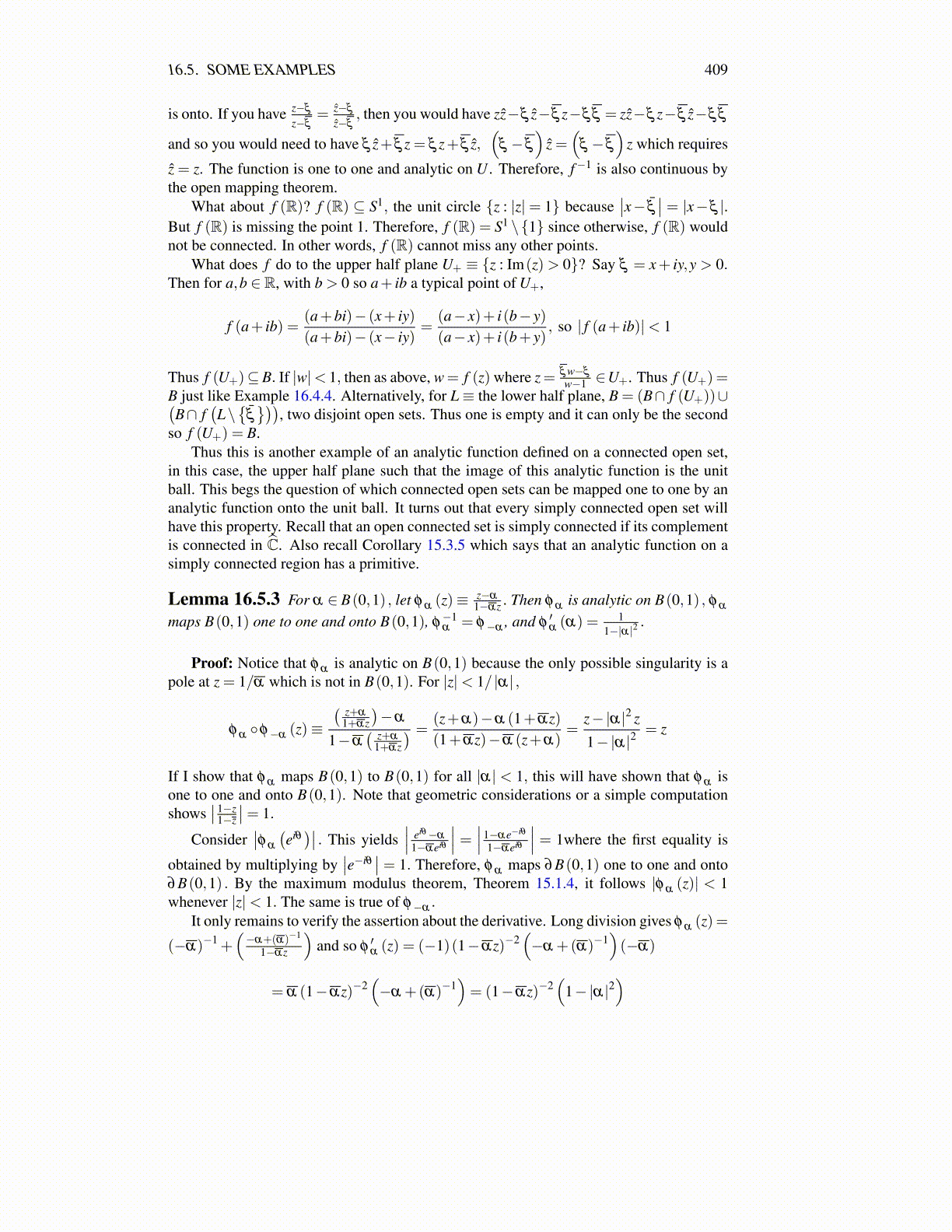
16.5. SOME EXAMPLES 409
is onto. If you have z−ξ
z−ξ= ẑ−ξ
ẑ−ξ, then you would have zẑ−ξ ẑ−ξ z−ξ ξ = zẑ−ξ z−ξ ẑ−ξ ξ
and so you would need to have ξ ẑ+ξ z = ξ z+ξ ẑ,(
ξ −ξ
)ẑ =
(ξ −ξ
)z which requires
ẑ = z. The function is one to one and analytic on U . Therefore, f−1 is also continuous bythe open mapping theorem.
What about f (R)? f (R) ⊆ S1, the unit circle {z : |z|= 1} because∣∣x− ξ̄
∣∣ = |x−ξ |.But f (R) is missing the point 1. Therefore, f (R) = S1 \{1} since otherwise, f (R) wouldnot be connected. In other words, f (R) cannot miss any other points.
What does f do to the upper half plane U+ ≡ {z : Im(z)> 0}? Say ξ = x+ iy,y > 0.Then for a,b ∈ R, with b > 0 so a+ ib a typical point of U+,
f (a+ ib) =(a+bi)− (x+ iy)(a+bi)− (x− iy)
=(a− x)+ i(b− y)(a− x)+ i(b+ y)
, so | f (a+ ib)|< 1
Thus f (U+)⊆B. If |w|< 1, then as above, w= f (z) where z= ξ w−ξ
w−1 ∈U+. Thus f (U+) =B just like Example 16.4.4. Alternatively, for L≡ the lower half plane, B = (B∩ f (U+))∪(B∩ f
(L\{
ξ̄}))
, two disjoint open sets. Thus one is empty and it can only be the secondso f (U+) = B.
Thus this is another example of an analytic function defined on a connected open set,in this case, the upper half plane such that the image of this analytic function is the unitball. This begs the question of which connected open sets can be mapped one to one by ananalytic function onto the unit ball. It turns out that every simply connected open set willhave this property. Recall that an open connected set is simply connected if its complementis connected in Ĉ. Also recall Corollary 15.3.5 which says that an analytic function on asimply connected region has a primitive.
Lemma 16.5.3 For α ∈ B(0,1) , let φ α (z)≡ z−α
1−αz . Then φ α is analytic on B(0,1) , φ α
maps B(0,1) one to one and onto B(0,1), φ−1α = φ−α , and φ
′α (α) = 1
1−|α|2.
Proof: Notice that φ α is analytic on B(0,1) because the only possible singularity is apole at z = 1/α which is not in B(0,1). For |z|< 1/ |α| ,
φ α ◦φ−α (z)≡( z+α
1+αz
)−α
1−α( z+α
1+αz
) = (z+α)−α (1+αz)(1+αz)−α (z+α)
=z−|α|2 z
1−|α|2= z
If I show that φ α maps B(0,1) to B(0,1) for all |α| < 1, this will have shown that φ α isone to one and onto B(0,1). Note that geometric considerations or a simple computationshows
∣∣ 1−z1−z
∣∣= 1.
Consider∣∣φ α
(eiθ)∣∣ . This yields
∣∣∣ eiθ−α
1−αeiθ
∣∣∣ = ∣∣∣ 1−αe−iθ
1−αeiθ
∣∣∣ = 1where the first equality is
obtained by multiplying by∣∣e−iθ
∣∣ = 1. Therefore, φ α maps ∂B(0,1) one to one and onto∂B(0,1) . By the maximum modulus theorem, Theorem 15.1.4, it follows |φ α (z)| < 1whenever |z|< 1. The same is true of φ−α .
It only remains to verify the assertion about the derivative. Long division gives φ α (z) =
(−α)−1 +(−α+(α)−1
1−αz
)and so φ
′α (z) = (−1)(1−αz)−2
(−α +(α)−1
)(−α)
= α (1−αz)−2(−α +(α)−1
)= (1−αz)−2
(1−|α|2
)